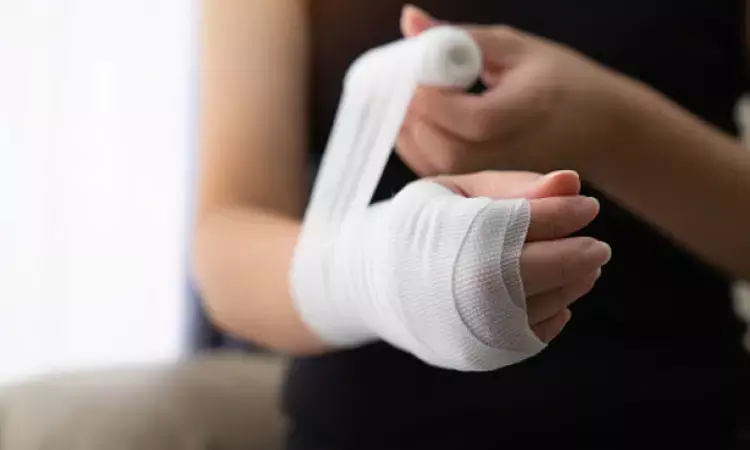- Home
- Medical news & Guidelines
- Anesthesiology
- Cardiology and CTVS
- Critical Care
- Dentistry
- Dermatology
- Diabetes and Endocrinology
- ENT
- Gastroenterology
- Medicine
- Nephrology
- Neurology
- Obstretics-Gynaecology
- Oncology
- Ophthalmology
- Orthopaedics
- Pediatrics-Neonatology
- Psychiatry
- Pulmonology
- Radiology
- Surgery
- Urology
- Laboratory Medicine
- Diet
- Nursing
- Paramedical
- Physiotherapy
- Health news
- Fact Check
- Bone Health Fact Check
- Brain Health Fact Check
- Cancer Related Fact Check
- Child Care Fact Check
- Dental and oral health fact check
- Diabetes and metabolic health fact check
- Diet and Nutrition Fact Check
- Eye and ENT Care Fact Check
- Fitness fact check
- Gut health fact check
- Heart health fact check
- Kidney health fact check
- Medical education fact check
- Men's health fact check
- Respiratory fact check
- Skin and hair care fact check
- Vaccine and Immunization fact check
- Women's health fact check
- AYUSH
- State News
- Andaman and Nicobar Islands
- Andhra Pradesh
- Arunachal Pradesh
- Assam
- Bihar
- Chandigarh
- Chattisgarh
- Dadra and Nagar Haveli
- Daman and Diu
- Delhi
- Goa
- Gujarat
- Haryana
- Himachal Pradesh
- Jammu & Kashmir
- Jharkhand
- Karnataka
- Kerala
- Ladakh
- Lakshadweep
- Madhya Pradesh
- Maharashtra
- Manipur
- Meghalaya
- Mizoram
- Nagaland
- Odisha
- Puducherry
- Punjab
- Rajasthan
- Sikkim
- Tamil Nadu
- Telangana
- Tripura
- Uttar Pradesh
- Uttrakhand
- West Bengal
- Medical Education
- Industry
Milder opioids preferable for subacute pain after surgery in fracture cases: JAMA

Australia: In a new study, it was shown that treating pain with powerful opioid medication sub acutely was not preferable to treating pain with milder medication in patients with surgically treated orthopedic fractures.
The findings of this study were published in the Journal of American Medical Association (JAMA) on 17th November 2021.
Patients with surgically treated fractures are frequently released from the hospital with a heavy opioid prescription, however, evidence to support this practice is inadequate. Deanne E. Jenkin and the team with the team aimed to investigate the hypothesis that powerful opioids offer more analgesic than light opioids during the first week following fracture surgical therapy.
This randomized, double-blind, superiority experiment was carried out at a single-center major trauma hospital in Sydney, Australia. Participants were inpatients treated with a surgical fixation for an acute nonpathological fracture of a long bone of the pelvis, patella, calcaneus, or talus from July 27, 2016, to August 22, 2017. The data were evaluated from June through October of 2018. At discharge, start oxycodone hydrochloride 5 mg or 10 mg (i.e., 1 or 2 tablets) or acetaminophen and codeine 500 mg and 8 mg or 1000 mg and 16 mg (i.e., 1 or 2 tablets) 4 times daily for up to 3 weeks.
This randomized, double-blind, superiority experiment was carried out at a single-center major trauma hospital in Sydney, Australia. Participants were inpatients treated with a surgical fixation for an acute non-pathological fracture of a long bone of the pelvis, patella, calcaneus, or talus from July 27, 2016, to August 22, 2017. The data were evaluated from June through October of 2018. At discharge, start oxycodone hydrochloride 5 mg or 10 mg (i.e., 1 or 2 tablets) or acetaminophen and codeine 500 mg and 8 mg or 1000 mg and 16 mg (ie, 1 or 2 tablets) 4 times daily for up to 3 weeks.
The primary outcome was the mean of daily pain ratings collected during the first week of therapy using the Numerical Pain Rating Scale (NRS). Participants were asked to assess their average pain over the past 24 hours using an NRS score ranging from 0 to 10, with 0 signifying no pain and 10 being the most severe pain possible. The EuroQol 5-Dimension 5-Level Questionnaire (EQ-5D-5L) answers, worst pain, pharmaceutical adverse events, global perceived impact, and return to work were the primary secondary objectives.
The results stated as follow:
1. A total of 120 patients with one or more acute orthopedic fractures needing surgical fixation were randomized, with 59 patients receiving strong opioids and 61 receiving moderate opioids.
2. The mean daily NRS mean pain score was 4.04 in the strong opioid group and 4.54 in the moderate opioid group from day 1 to day 7 after discharge.
3. Despite a 6-fold increase in opioid dosage in the strong opioid group, the between-group difference in the main outcome was not statistically significant.
In conclusion, the authors suggested that, treatment with powerful opioids was not shown to be preferable to management with a milder opioid prescription for post-discharge treatment of subacute pain in patients with surgically treated orthopedic fractures, according to this study. These data show that continued heavy opioid usage after hospital discharge should be discouraged.
Reference:
Jenkin DE, Naylor JM, Descallar J, Harris IA. Effectiveness of Oxycodone Hydrochloride (Strong Opioid) vs Combination Acetaminophen and Codeine (Mild Opioid) for Subacute Pain After Fractures Managed Surgically: A Randomized Clinical Trial. JAMA Netw Open. 2021;4(11):e2134988. doi:10.1001/jamanetworkopen.2021.34988
Medical Dialogues consists of a team of passionate medical/scientific writers, led by doctors and healthcare researchers. Our team efforts to bring you updated and timely news about the important happenings of the medical and healthcare sector. Our editorial team can be reached at editorial@medicaldialogues.in.
Dr Kamal Kant Kohli-MBBS, DTCD- a chest specialist with more than 30 years of practice and a flair for writing clinical articles, Dr Kamal Kant Kohli joined Medical Dialogues as a Chief Editor of Medical News. Besides writing articles, as an editor, he proofreads and verifies all the medical content published on Medical Dialogues including those coming from journals, studies,medical conferences,guidelines etc. Email: drkohli@medicaldialogues.in. Contact no. 011-43720751


